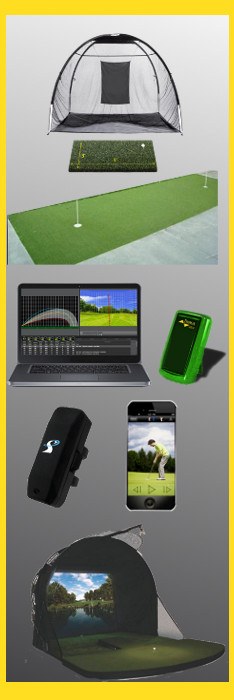Golf makes addicts of us all. Well, most of us, anyway. When the bug bites, your drive to improve can overwhelm the constraints of daily life. Who’s got time to hit the range and the practice green every day? Not you, right?
These days, you’ve got a choice. Instead of dragging yourself out to the practice facility, you can bring the practice facility to your home. And you don’t need a 5-acre pasture or even a backyard. An outdoor deck, garage or spacious living room will do.
Here are five items that can help turn any home into your personal golf practice palace.

Hitting Mat with Net: Naturally, you’ll need something to hit from besides concrete, wood, linoleum or your prize-winning zoysia lawn. Today’s synthetic golf mats offer a surprisingly realistic surface that emulates course turf far better than the mats of yesteryear ever did. Many have adjustable teeing heights as well
Assuming you don’t live on a ranch, you’ll need something to catch your shots before they break something. The golf market is full of suitable nets, some of which fold up for easy portability. Basic models include just a single net, while others offer full left, right and top enclosures.
Cost: Bargain basement – Less than $100 for a mat, less than $50 for net. Top-of-the-line – Up to $700 for mat; up to $600 for net.
Synthetic Putting Green: Sure, you can putt on your shag carpet or hardwood floor, but few home floors provide true-to-life speed and roll. Synthetic greens do just that. They run the gamut from basic models – a few feet wide and 5’ – 8’ long, with a single cup – to multi-hole spreads that would shame your local putt-putt. You can have a green custom-built, too, complete with humps and swales.
Cost: Bargain basement – Less than $50. Top-of-the-line – $1,000 and up… Way up for a large, custom-built green.
Launch Monitor: Not so long ago, you had to visit a professional clubfitter to determine important data such as clubhead speed and launch angle. Now, all it takes is a few hundred bucks. Compact, portable launch monitors for the range or home require no extra space to set up, and they generate accurate info instantaneously.
Of course, you can always go big with a professional-quality monitor that tells you more than you’ll ever need to know about your ball’s flight characteristics. It’ll cost you, though.
Cost: Bargain basement – About $250. Top-of-the-line – $5,000 and up.
Swing Analysis Devices: These modern marvels not only spit out figures like club speed and face angle, they capture a 3D image of your swing which you can download and view on a smartphone, tablet, laptop or PC. One such model is simply inserted into your club’s grip, while another clips onto your club. Pro-grade swing analysis equipment includes motion-capture technology and high-tech cameras.
Cost: Bargain basement – Less than $150. Top-of-the-line – Several thousand dollars.
Golf Simulator: For those with unlimited funds, this is definitely the way to go. An in-home simulator offers everything you need in a practice setup, plus a whole lot more. As in, incredibly life-like graphics that let you “play” the world’s greatest golf courses, including Pebble Beach and Augusta National.
If you love the idea but don’t have six figures to spend, lower-end simulators display the course on your computer screen as you hit into a net – still pretty darn cool.
Cost: Bargain basement — $399. Top-of-the-line: You don’t want to know… OK, upwards of $90,000.





